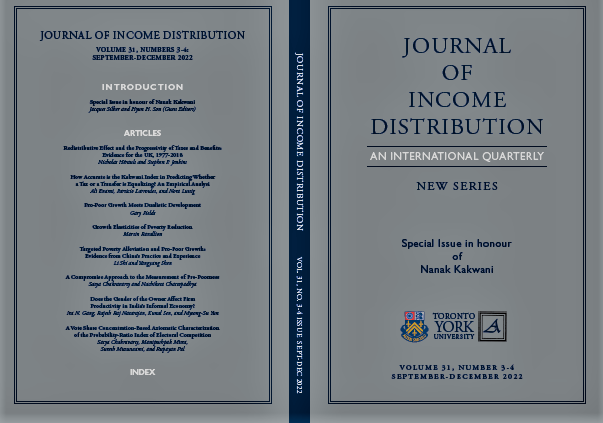Pro-Poor Growth Meets Dualistic Development
DOI:
https://doi.org/10.25071/1874-6322.40544Keywords:
Pro-poor growth, dualistic development, two-sector economy, poverty, axiomaticsAbstract
Pro-poor growth refers to how incomes change for the poor and for others
when economic growth occurs. Dualistic development refers to three types
of economic growth patterns in a two-sector economy: 1) modern sector
enrichment, 2) traditional sector enrichment, and 3) modern sector
enlargement. The question asked in this article is, what can we say about
the pro-poorness of each of the three types of dualistic development? The
main conclusion I reach is that pro-poor growth works well for the first two
dualistic growth types but runs into some difficulties for the third. To
overcome these problems, I posit some axioms for dualistic development –
particularly, by treating pro-richness and pro-poorness as distinct orderings.
References
Anand, S., and S.M. Kanbur 1993 “The Kuznets Process and the Inequality-Development Relationship”, Journal of Development Economics 40(1): 25–52.
Atkinson, A.B. 1987 “On the Measurement of Poverty”, Econometrica 55(4): 749–764.
Bárcena-Martin, E., and J. Silber 2019 “On the Measurement of Population-Weighted Relative Indices of Mobility and Convergence, with an Illustration Based on Chinese Data”, Paper No. 505., ECINEQ, Society for the Study of Economic Inequality, Conference presentation
Paris, July.
Bourguignon, F. 2011 “Non-Anonymous Growth Incidence Curves, Income Mobility and Social Welfare Dominance”, Journal of Economic Inequality 9(4): 605–627.
Chakravarty, S. R., N. Chattopadhyay, and C. D’Ambrosio 2019 “Pro-Poorness Orderings”, Review of Income and Wealth 65(4): 785–803.
Chenery, H. 1979 Structural Change and Development Policy London: Oxford University Press.
Dollar, D., and A. Kraay 2002 “Growth Is Good for the Poor”, Journal of Economic Growth 7(3): 195–225.
—–, T. Kleineberg, and A. Kraay 2016 “Growth Still Is Good for the Poor”, European Economic Review 81: 68–85.
Duclos, J.Y. 2009 “What Is ‘Pro-Poor?”, Social Choice and Welfare 32(1): 37–58.
Duval-Hernández, R., G.S. Fields, and G.H. Jakubson 2022 “Inequality and Panel Income Changes: Conditions for Possibilities and Impossibilities”, International Economic Review DOI: 10.1111/iere.12603.
Essama-Nssah, B., and P.J. Lambert 2009 “Measuring Pro-Poorness: A Unifying Approach”, Review of Income and Wealth 55(3): 752–778.
Fei, J.C.H., and G. Ranis 1964 Development of the Labor Surplus Economy Homewood, IL: Irwin.
Fields, G.S. 1979 “A Welfare Economic Analysis of Growth and Distribution in the Dual Economy”, Quarterly Journal of Economics 93(3): 325–353.
—– 1980 Poverty, Inequality, and Development Cambridge: Cambridge University Press.
—– 1987“Measuring Inequality Change in an Economy with Income Growth”, Journal of Development Economics 26(2): 357–374.
—– 2001 Distribution and Development: A New Look at the Developing World Cambridge, MA: MIT Press / New York: Russell Sage Foundation.
—– 2012 Working Hard, Working Poor New York: Oxford University Press.
—– 2019 Employment and Development: How Work Can Lead from and into Poverty New York: Oxford University Press.
Foster, J., J. Greer, and E. Thorbecke 1984 “A Class of Decomposable Poverty Measures”, Econometrica 52: 761–776.
Grimm, M. 2007 “Removing the Anonymity Axiom in Assessing Pro-Poor Growth”, Journal of Economic Inequality 5(2): 179–197.
Grosse, M., K. Harttgen, and S. Klasen 2008 “Measuring Pro-Poor Growth in Non-Income Dimensions”, World Development 36(6): 1021–1047.
Jenkins, S.P., and P. Van Kerm 2006 “Trends in Income Inequality, Pro-Poor Income Growth, and Income Mobility”, Oxford Economic Papers 58(3): 531–548.
Johnston, B., and P. Kilby 1975 Agriculture and Structural Transformation London: Oxford University Press.
Kakwani, N. 1980 Income Inequality and Poverty: Methods of Estimation and Policy Applications Oxford: Oxford University Press.
—– 2000 “Growth and Poverty Reduction: An Empirical Analysis” Asian Development Review, 18(2): 74–84.
—–, and E.M. Pernia 2000 “What Is Pro-Poor Growth?”, Asian Development Review 18(1): 1–16.
—–, B. Prakash, and H. Son 2000 “Growth, Inequality, and Poverty: An Introduction”, Asian Development Review 18(2): 1–21.
—–, S. Khandker, and H.H. Son 2004 “Pro-Poor Growth: Concepts and Measurement with Country Case Studies”, International Poverty Centre Working Paper 1, August.
—–, and H.H. Son, 2008 “Poverty Equivalent Growth Rate”, Review of Income and Wealth 54(4): 643–655.
—–, and H.H. Son 2016 Social Welfare Functions and Development London: Macmillan Publishers Ltd. / Springer Nature.
Kuznets, S. 1955 “Economic Growth and Income Inequality”, American Economic Review March: 1–28.
—– 1966 Modern Economic Growth New Haven, CT: Yale University Press.
Lewis, W.A. 1954 “Economic Development with Unlimited Supplies of Labour”, The Manchester School 12: 139–191.
McMillan, M., D. Rodrik, and Í. Verduzco-Gallo 2014 “Globalization, Structural Change, and Productivity Growth, with an Update on Africa”, World Development 63: 11–32.
Merotto, D., M. Weber, and R. Aterido 2018 “Pathways to Better Jobs in IDA Countries” World Bank Jobs Series (14).
Monga, C. 2019 “Jobs: An African Manifesto”, in Célestin Monga, Abebe Shimeles, and Andinet Woldemichael, eds., Creating Decent Jobs: Strategies, Policies, and Instruments Côte d’Ivoire: African Development Bank, pp. 1–47
—–, and J.Y. Lin 2019 The Oxford Handbook of Structural Transformation Oxford: Oxford University Press.
Ravallion, M. 2004 “Pro-Poor Growth: A Primer” World Bank Paper WPS 3242.
—– 2016 The Economics of Poverty: History, Measurement, and Policy New York: Oxford University Press.
—–, and S. Chen 2003 “Measuring Pro-Poor Growth”, Economics Letters 78(1): 93–99.
Solow, R. 1956 “A Contribution to the Theory of Economic Growth”, Quarterly Journal of Economics 70: 65–96.
Son, H. 2004 “A Note on Pro-Poor Growth”, Economics Letters 82(3): 307–314.
Squire, L. 1981 Employment Policy in Developing Countries: A Survey of Issues and Evidence Oxford: Oxford University Press.
Swan, T. 1956 “Economic Growth and Capital Accumulation”, Economic Record 32: 334–361.
Turnham, D. 1971 The Employment Problem in Less Developed Countries Paris: Organization for Economic Cooperation and Development.
—– 1993 Employment and Development: A New Review of Evidence Paris: Organization for Economic Cooperation and Development.
Warr, P. 2005 “Pro-Poor-Growth” Asian-Pacific Economic Literature 19(2), 1–17.





